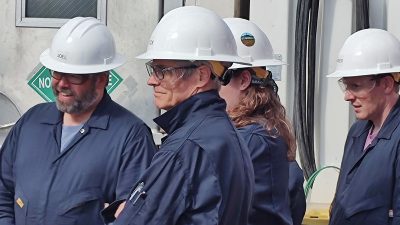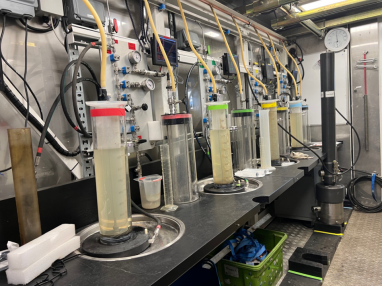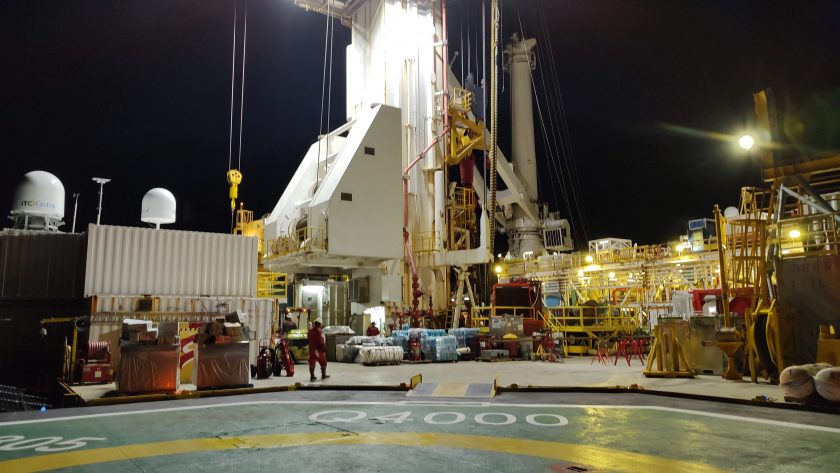Progress from Delay
August 8, 2023
Editors Note: Scientists from the UT Jackson School of Geosciences and partner universities are in the Gulf of Mexico on a mission funded by the Department of Energy to sample and study methane hydrate, a difficult to reach and poorly understood substance with potentially wide-ranging effects on the planet’s environment, climate and energy resources. Led by Jackson School Professor Peter Flemings, the scientific team includes researchers from the U.S. Geological Survey, Ohio State University, the University of Washington, Oregon State University, the University of New Hampshire, the Colorado School of Mines and Tufts University. Jackson School Science Writer Monica Kortsha and videographer Drew Ott joined the team to document the work and tell the story. Follow the expedition here.
By Monica Kortsha
Over the past four days at sea, the science team has faced the following issues:
- The “T2P” – a temperature and pressure probe refined for the methane hydrate mission – was shelved after free-falling 6,500 feet to the bottom of the seafloor during a test run. The probe was supposed to probe each sediment layer before coring. But since nobody wants to risk another “fishing expedition,” the tool is out of the picture.
- The first attempt at a pressure core didn’t seal correctly. A core was recovered, but it was a mixed-up slurry of sediment that didn’t offer much insight into the geology of the reservoir.
- During the third pressure coring attempt, the wireline parted and the pressure coring tool spent hours stuck in the mud at the bottom of the drill string until a new line was attached and the mud was cleared.
 Thankfully, each obstacle has been overcome to different degrees. Pressure readings aren’t available but a probe on the coring tool is taking temperatures. The pressure-valve sealed on the second attempt, capturing a beautiful pressurized core sample, which after having its wireline replaced and fluid circulated around it, broke free from the seafloor and rose up to the drill crew and science team awaiting its arrival.
Thankfully, each obstacle has been overcome to different degrees. Pressure readings aren’t available but a probe on the coring tool is taking temperatures. The pressure-valve sealed on the second attempt, capturing a beautiful pressurized core sample, which after having its wireline replaced and fluid circulated around it, broke free from the seafloor and rose up to the drill crew and science team awaiting its arrival.
Although the process of getting the core comes with curveballs, it’s worth it. That’s because with each core The University of Texas at Austin-led science team is building a better and better picture of the methane hydrate reservoir below, and learn more about how this cache of carbon formed and the effects it could have on the planet if the methane exits from its solid hydrate form.
The cores that offer the best picture of the reservoir preserve the layers of sediment – and any chunks of methane hydrate that may be in it – in the same stratigraphic layers they were found in on the sea floor.
That’s an awfully hard thing to do when the methane gas trapped inside the cores wants to rise up out of the sample as the pressure decreases, and the seawater and drilling fluid circulating around the coring tool in the borehole wants to go down into it, said the mission’s lead sedimentologist Joel Johnson, a professor at the University of New Hampshire.
 Nevertheless, despite some hic-ups, most of the intact cores that have been pulled so far – seven conventional cores, two pressurized cores, and counting – are in great condition for further study.
Nevertheless, despite some hic-ups, most of the intact cores that have been pulled so far – seven conventional cores, two pressurized cores, and counting – are in great condition for further study.
For some teams, the delays weren’t all bad. In a mission running 24-hours a day, it provided precious time to catch up on processing the samples they already had – and prepare to capture the fleeting ephemeral samples contained in freshly caught core. These samples include elements like iron in its liquid phase present in the pore water, which readily precipitates into its more common solid form if left alone for too long. It includes sediment samples that may house colonies of microbes responsible for both generating the methane that goes on to form the hydrates, and consuming it, that could easily be contaminated by their surface cousins if they aren’t preserved in a sterile setting. And of course, there’s the methane, which is sampled from just about every nook and cranny of each core – from the gas dissolved in the pore water between the sediments, to the gas that fills large visible gaps called voids.
In short, it’s a lot. (And that’s not even all of it.) Although it might not be in the mission plan, these delays have their upsides for the scientists tasked with keeping science going night and day.
This is the second post in the series. Read the first post here.

